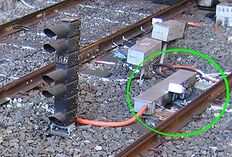Train stops, also known as trips, tripcocks and tripstops, are devices fitted to most signals on the Sydney Trains metropolitan and intercity network. They are a safety device which can apply the emergency brakes on trains.

An example of a train stop in Melbourne, very similar, if not the same to ones used in NSW.
Description[]
Trains stops are small lineside devices with a movable arm (powered by electricity or air). They are always mounted on the left side in the direction of travel.
Train stops are connected to a signal. When that signal shows a red signal, the trip arm will come up. If a train tries to go past the signal, the arm will strike the trip cock on the train, which then will apply the emergency brakes on the train.
In some cases, when the signal is displaying a calling on aspect, the train stop will also not drop. This ensures that the train moves past the signal at a slow enough speed, ready to stop short of an obstruction. This is because the calling on indication does not necessarily indicatate that the line ahead is clear.
Note that train stops will only apply the brakes after a train has passed a red signal. Because of this, the signalling system will ensure an overlap beyond the signal is clear, to allow room for a train that passes the red signal to stop. Where this is not possible, catch points can be installed to derail a train out of the way, or trains can have their speed checked by low speed train stops at previous signals.
Like most safety devices, they are not completely failsafe. In the case of a signal failure, drivers will be instructed to trip past failed signals (strike the trip arm at low speed and continue once the brake pipe is full). This can have disasterous consequences if drivers are not careful, such as in the Glenbrook Train Crash, when a V set struck the Indian Pacific after tripping past a failed signal.
Special Train Stops[]
Low speed train stop[]
This is a type of train stop attached to a signal that can display a low speed indication. The trip arm still works normally while the signal is at stop. However, when the signal is changed to low speed, the arm will stay up. As the train approaches the signal, sensors will measure the speed of the train, by counting how long it takes for the train to pass a certain section. If the speed is under 25km/h, the trip arm will drop and the train will be able to pass. However, if the train is over 25km/h, the train will strike the trip and be brought to a halt.
Intermediate trips[]
These train stops are found along the length of a platform, seemingly not connected to any signal. However, they are connected to the signal at the end of the platform. When the signal at the end of the platform is at stop, all the trips will come up and act like a low speed trip. They will force the train to slow down for the red signal. The last trip, closest to the signal, requires a speed of about 4km/h.
Both low speed and intermediate trips allow for trains to run closer together, hence they are only found on core sections of the network such as the City Circle. They allow for increased safety as they will stop a fast moving train much earlier than if there was only one train stop.
Fixed train stops[]
These are train stops that are stuck in the up position, to protect dead ends. They normally have the shape of a triangular prism.
Reverse Direction[]
When the train is going backwards through a train stop for any reason (e.g. bidirectional signalling), the train stop will come down even if it is at stop. This is because there may be other driving cars on the train facing the right direction to be struck.
